plow
 As we head into Spring, the Farmers start planning for the spring planting. In man’s early years, that meant finding a stick to poke a hole in the ground so the seeds could be placed in the hole and covered. While that may have been fine for the small one-family garden, it was ineffective for the large farms we have today. Supplying many people with food, like today’s farmers do, means that plowing and planting has to be more streamlined.
As we head into Spring, the Farmers start planning for the spring planting. In man’s early years, that meant finding a stick to poke a hole in the ground so the seeds could be placed in the hole and covered. While that may have been fine for the small one-family garden, it was ineffective for the large farms we have today. Supplying many people with food, like today’s farmers do, means that plowing and planting has to be more streamlined.
Watching shows like Little House on the Prairie, and others that took in a planting period, most of us have seen the hand plow used by farmers in the Old West. It was hooked up to a horse, and the farmer had to not only follow  behind the horse, being careful to keep up, but also to force the blade of the plow into the dirt to turn it over. The plow worked, but it was very labor intensive…and in the heat of the day, a man could get heat stroke plowing his field…literally!!
behind the horse, being careful to keep up, but also to force the blade of the plow into the dirt to turn it over. The plow worked, but it was very labor intensive…and in the heat of the day, a man could get heat stroke plowing his field…literally!!
The wheeled plow, which was drawn by oxen at first, but later by horses, made possible the northward spread of European agriculture. Finally, the farmer could sit and let the horse and machine do the work. It was still hot in the mid-day sun, but the work wasn’t so labor intensive. The 18th-century addition of the moldboard, which turned the furrow slice cut by the 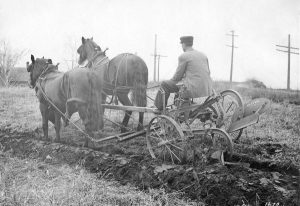 plowshare, was an important advance. The black hard-packed soil in the American Midwest in the mid-19th century challenged the strength of the existing plow. That was when American mechanic John Deere invented the all-steel one-piece share and moldboard. The three-wheel sulky plow followed and finally, with the introduction of the gasoline engine the tractor-drawn plow. Further improvements followed until we had the advanced farming equipment we have today. The plow has come a long way, and the work of a farmer has become a little easier, but it is still hard work, and without the farmers we would have serious food shortages. Thank you to all our farmers!! Don’t forget to thank a farmer today.
plowshare, was an important advance. The black hard-packed soil in the American Midwest in the mid-19th century challenged the strength of the existing plow. That was when American mechanic John Deere invented the all-steel one-piece share and moldboard. The three-wheel sulky plow followed and finally, with the introduction of the gasoline engine the tractor-drawn plow. Further improvements followed until we had the advanced farming equipment we have today. The plow has come a long way, and the work of a farmer has become a little easier, but it is still hard work, and without the farmers we would have serious food shortages. Thank you to all our farmers!! Don’t forget to thank a farmer today.
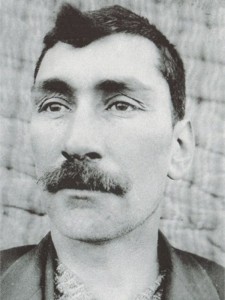 Like many people, my great grand uncle, Cornealius Spencer and his wife Leola Stinson Spencer left Iowa and made their way to Oklahoma in the spring of 1893. With them were their children and Leola’s parents. They had heard that the government was giving away land and they had decided to make a new start. The homestead they received was 160 acres, but the land came with qualifications. The homestead owner was required to fence the land, build a building, and live on the land for a period of one year before it became theirs. When I think of those reasonable qualifications, in light of today and all we have now, I think that the land they received was really cheap…and maybe it was, but times were different then, and living on a piece of land that had no improvements, and the soil was hard and rocky, might not have been so easy. They didn’t have the farming equipment we have now, so they had to till the ground with a team of horses or a yoke of oxen and a hand plow. They couldn’t just run down to the lumber store to buy building supplies. They had to cut down their own logs to build a home, or live in a sod hut…which many people then did for a time.
Like many people, my great grand uncle, Cornealius Spencer and his wife Leola Stinson Spencer left Iowa and made their way to Oklahoma in the spring of 1893. With them were their children and Leola’s parents. They had heard that the government was giving away land and they had decided to make a new start. The homestead they received was 160 acres, but the land came with qualifications. The homestead owner was required to fence the land, build a building, and live on the land for a period of one year before it became theirs. When I think of those reasonable qualifications, in light of today and all we have now, I think that the land they received was really cheap…and maybe it was, but times were different then, and living on a piece of land that had no improvements, and the soil was hard and rocky, might not have been so easy. They didn’t have the farming equipment we have now, so they had to till the ground with a team of horses or a yoke of oxen and a hand plow. They couldn’t just run down to the lumber store to buy building supplies. They had to cut down their own logs to build a home, or live in a sod hut…which many people then did for a time.
The families arrived with two covered wagons and Leola with two small children…four year old Oren and two year old Edith. The wagons were pulled by a pair of oxen. With no bits or lines to guide the oxen. They pulled the wagon by a yoke and Leola had to guide them by the voice commands or “gee” and “haw” for left and right and “whoa” for stop. The milk cow was tied to the wagon and the family brought along a coop of chickens. They camped out at night, and let the chickens eat the bugs in the area. There were no roads to get to Oklahoma, so they had to simply go across the prairie.
Once they arrived in Blaine county, the men filed on two places that were next to each other. Each place had a spring for water, until a well could be dug. They dug a dugout near the spring, and were settled by June 12, 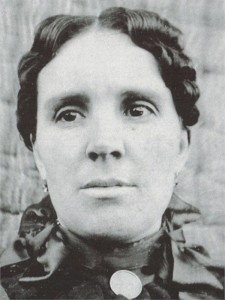 1893, when their new daughter Elsie Jane was born. They lived in the dugout until a home could be built. There were no towns close, so they had to rely on what they could hunt. Thankfully there was an abundance of deer, rabbits, turkeys, and even squirrels, so they never went hungry. Both Cornealius and Leola were excellent shots, so it didn’t matter who was available to hunt, both were able to get food for the family.
1893, when their new daughter Elsie Jane was born. They lived in the dugout until a home could be built. There were no towns close, so they had to rely on what they could hunt. Thankfully there was an abundance of deer, rabbits, turkeys, and even squirrels, so they never went hungry. Both Cornealius and Leola were excellent shots, so it didn’t matter who was available to hunt, both were able to get food for the family.
I can fully understand why it was so hard to make a homestead work now, because the supplies the homesteaders needed were not readily available. Many people gave up and headed back east, but my great grand uncle and his family stuck it out, and spent their remaining years in Oklahoma. They would raise their ten children there and were very successful in their endeavors. Homesteading wasn’t designed to be easy. Getting 160 acres of land is a big deal, and while the land ended up being free in the monetary sense, it certainly did not in the blood, sweat, and tears sense. The homesteader earned every inch of that property.
 In years gone by, most farmer’s children worked on the farms of their parents. Many still do, but the way they worked has change quite a bit. Back in the old west and beyond, the fields were plowed on foot using team of horses or oxen to assist in pulling the plow through the hard ground. It has hard work, and usually resulted in the blistering of hands that were not used to it. In those days, the women didn’t usually work the farms, unless there simply was no other choice, and women with calloused hands were looked down upon and thought to be…well, not really a true lady…at least, not by Eastern standards. They just didn’t understand what it took to build the West. Many times, people moved out West with the promise of a homestead, and 5 years to prove the land. Money was scarce, and you did what you had to do…including setting your children to the task of helping out on the farm.
In years gone by, most farmer’s children worked on the farms of their parents. Many still do, but the way they worked has change quite a bit. Back in the old west and beyond, the fields were plowed on foot using team of horses or oxen to assist in pulling the plow through the hard ground. It has hard work, and usually resulted in the blistering of hands that were not used to it. In those days, the women didn’t usually work the farms, unless there simply was no other choice, and women with calloused hands were looked down upon and thought to be…well, not really a true lady…at least, not by Eastern standards. They just didn’t understand what it took to build the West. Many times, people moved out West with the promise of a homestead, and 5 years to prove the land. Money was scarce, and you did what you had to do…including setting your children to the task of helping out on the farm.
It is my opinion that the way things were done in the old West better trained the children for adulthood. I have watched so many kids go through life without having to shoulder any responsibility, and then continue on in life in the same way. Some becoming “professional students” so that they won’t have to get a job, while their parents pay their way. It’s a sad, sad situation, and one the parents find themselves having trouble getting out of.
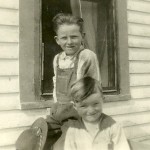
The kids in the old West understood that their help was needed or the family was not going to make it. School became a luxury and one that often ended after the eighth grade, if not before. Their time was needed elsewhere. Things have changed dramatically since then. Farm equipment has made the work on the farm much easier, and the children aren’t needed to the degree that they used to be. That is a good thing in that more kids finish school.They also have time to just be kids these days. I’m still not sure which is better…or maybe there is no better…just different.
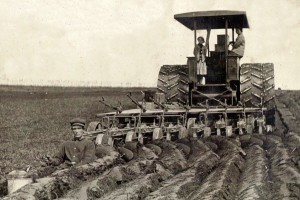 Sometimes I think my family had a lot of comedians in its past. As I look through the pictures from every part of my family, I continue to come up with pictures that are obviously staged intending to get a reaction. So many of the pictures I have seen from the past have families sitting in a studio without one smile among them, so it is surprising to see random pictures that show the subjects posed in odd ways or acting out moments of the old west. At first I thought these were post cards…until I recognized my grandfathers and other family members in the pictures. They were just posing for pictures that they could send back home to get a laugh out of the family back there, or just to show their friends. Either way, it tells me that my family has some great imaginations or a funny bone.
Sometimes I think my family had a lot of comedians in its past. As I look through the pictures from every part of my family, I continue to come up with pictures that are obviously staged intending to get a reaction. So many of the pictures I have seen from the past have families sitting in a studio without one smile among them, so it is surprising to see random pictures that show the subjects posed in odd ways or acting out moments of the old west. At first I thought these were post cards…until I recognized my grandfathers and other family members in the pictures. They were just posing for pictures that they could send back home to get a laugh out of the family back there, or just to show their friends. Either way, it tells me that my family has some great imaginations or a funny bone.
When I first looked at this picture, I didn’t notice anything unusual, but upon closer examination, I saw the man I believe to be my great uncle low to the ground in front of the plow. At first I thought I was seeing things. I looked again thinking it might be a child, but it was definitely a man. Then I wondered how he was so low to the ground. He looked like he was in a hole up to his waist, but that was not the case. No, he was actually sitting in the furrow, so that it looked like he had just been plowed up. And the funny thing was that he was able to keep a perfectly straight face. Now I would have been laughing for sure if I was trying to pull that off. I guess that there are people who just have a knack for keeping a straight face in a joke situation.
Now that isn’t always the case, however. When my grandfather was involved  in a mock hold up, they simply couldn’t keep a straight face, including the intended victim. Those situations can be as funny as the ones where the comedian can keep a straight face, because when they get to laughing, it is contagious. You just laugh in spite of yourself. And that’s ok too. I have found many interesting characters in my family’s past, and they are each interesting in different ways. I think I would have enjoyed very much getting to know all of them. The comedians would have been especially fun, because there would never be a dull moment, and when you think about it, we can all use a good laugh from time to time.
in a mock hold up, they simply couldn’t keep a straight face, including the intended victim. Those situations can be as funny as the ones where the comedian can keep a straight face, because when they get to laughing, it is contagious. You just laugh in spite of yourself. And that’s ok too. I have found many interesting characters in my family’s past, and they are each interesting in different ways. I think I would have enjoyed very much getting to know all of them. The comedians would have been especially fun, because there would never be a dull moment, and when you think about it, we can all use a good laugh from time to time.
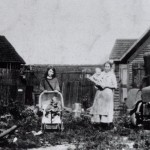
 I don’t pretend to know a lot of the details of my dad’s young life. I do know that the times weren’t always easy, and since my grandfather, who worked for the railroad, wasn’t around much, the kids helped out around the place. My grandmother was a very strong woman, and she was very capable of running the farm. That may have been how many of the women were back then, but as strong women go, she was right up there at the top, or so I’m told. She trained her children to be hard workers, and responsible people, and they all were. My Uncle Bill and my dad told me about blowing tree stumps out of the fields with dynamite so the land could be worked. I’m sure they didn’t mind that job too much, since dynamite was something the also played around with…like blowing gate posts deeper into the ground, only to have to fix it before their mom got back from town. My guess is that she was about the only thing they were afraid of.
I don’t pretend to know a lot of the details of my dad’s young life. I do know that the times weren’t always easy, and since my grandfather, who worked for the railroad, wasn’t around much, the kids helped out around the place. My grandmother was a very strong woman, and she was very capable of running the farm. That may have been how many of the women were back then, but as strong women go, she was right up there at the top, or so I’m told. She trained her children to be hard workers, and responsible people, and they all were. My Uncle Bill and my dad told me about blowing tree stumps out of the fields with dynamite so the land could be worked. I’m sure they didn’t mind that job too much, since dynamite was something the also played around with…like blowing gate posts deeper into the ground, only to have to fix it before their mom got back from town. My guess is that she was about the only thing they were afraid of.
My Aunt Laura was ten years older than my Uncle Bill, who was the second child, so she helped with caring for the little ones so her mom could do the other things she needed to do. I’m quite sure that running a farm would have been very difficult without the help of my Aunt Laura, not to mention lonely in those early years, when the younger children weren’t much company. There were fun times too, of course, such as fishing, which the boys thoroughly enjoyed, but there was always work to be done, and the fun times were squeezed into the middle.
Everyone helped out…the girls as well as the boys. From running a horse drawn plow to a tractor, stacking hay and caring for the animals, it was a team effort. The kids had great respect for their mother and would do anything for her. It was a time that was much different from our own. There weren’t as many conveniences, so the land had to be worked in the old ways…using horses. I don’t think my Aunt Ruth minded that too much because many of the pictures I saw her in included horses. They did have a tractor, although I don’t think it was in the early years, but when they did, it was obvious that my Uncle Bill enjoyed using it very much. The boys always liked machinery…throughout their entire lives.
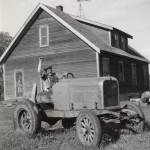
Life on a farm in the late 1920’s and early 1930’s was difficult at its best, and downright ugly at it worst, and it took strong men and women to make things work, but that really is what our country is all about…strong people doing their best to do what is right and good. It is our heritage, and it’s not a bad one. Strong people are what built this country and I believe there are still a lot of us around to continue to make this country great.

